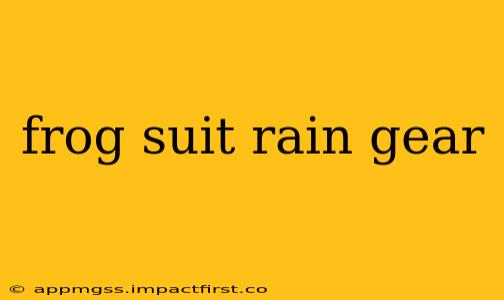Staying dry and comfortable in the rain is crucial, whether you're a seasoned outdoor enthusiast or simply navigating your daily commute. While traditional raincoats and ponchos offer protection, the innovative frog suit rain gear provides a whole new level of waterproof comfort and style. This comprehensive guide delves into everything you need to know about frog suit rain gear, addressing common questions and highlighting its unique advantages.
What is a Frog Suit Rain Gear?
Frog suit rain gear, also sometimes referred to as a frog tog or froggy suit, is a type of waterproof outerwear designed for complete protection from the elements. Unlike traditional rain jackets and pants, frog suits are one-piece garments that completely encase the wearer, typically extending from the neck to the ankles. This design eliminates gaps where water could seep in, providing superior protection from heavy rain, wind, and even splashes. They often feature sealed seams, waterproof zippers, and adjustable cuffs and hoods to ensure a snug and leak-proof fit. The name "frog suit" is derived from its resemblance to the smooth, water-repellent skin of a frog.
What are the Benefits of Wearing a Frog Suit?
The primary benefit of a frog suit is its superior water resistance. The one-piece design eliminates vulnerable areas found in traditional two-piece rain gear, offering comprehensive protection against heavy downpours and strong winds. Additionally, frog suits:
- Offer enhanced mobility: While some may assume a one-piece suit restricts movement, many modern designs are tailored for comfort and flexibility, allowing for a wide range of motion.
- Provide superior warmth: The fully enclosed design traps a layer of warm air close to the body, providing greater insulation than a typical rain jacket and pants combination.
- Are often more durable: Made from high-quality, waterproof materials, frog suits are often built to withstand harsh conditions and prolonged use.
- Can be more stylish: Frog suits are available in a range of colors and styles, allowing you to stay dry and look good doing it.
What are the Different Types of Frog Suit Rain Gear?
Frog suit rain gear comes in a variety of materials and styles. The most common materials include:
- PVC: Offers excellent water resistance and durability but can be less breathable.
- Nylon: Often treated with a durable water repellent (DWR) coating to create a waterproof barrier, and can be more breathable than PVC.
- Polyester: Lightweight and breathable options are available, often treated with DWR for water resistance.
Different styles might include variations in features like:
- Hood styles: Detachable, adjustable, or integrated hoods.
- Pocket styles: Multiple pockets for added storage.
- Reflective elements: Improve visibility in low-light conditions.
How to Choose the Right Frog Suit for Your Needs?
Choosing the right frog suit depends on your individual needs and preferences. Consider the following factors:
- Activity level: If you'll be engaging in strenuous activity, prioritize breathability.
- Climate conditions: Consider the typical rainfall and temperature in your area.
- Durability: Choose a durable material if you'll be using the suit frequently or in challenging conditions.
- Fit: A well-fitting suit is essential for comfort and mobility.
How to Clean and Maintain Your Frog Suit?
Proper cleaning and maintenance will extend the life of your frog suit. Follow the manufacturer's instructions carefully. Generally, you should:
- Rinse with clean water after each use: This removes dirt and debris that could compromise the waterproof coating.
- Air dry completely: Avoid using a dryer, which could damage the material.
- Store properly: Store your suit in a cool, dry place to prevent mildew and damage.
Is a Frog Suit Right for Me?
Whether a frog suit is right for you depends on your individual needs and preferences. If you need complete protection from the elements and don't mind a one-piece design, a frog suit could be a great option. However, if you prioritize breathability during intense activities, other rain gear options might be better suited.
What are the drawbacks of wearing a frog suit?
While offering excellent protection, some potential drawbacks of frog suits include:
- Limited breathability: Some materials are less breathable than others, leading to potential overheating during strenuous activity.
- Bulkiness: Frog suits can be bulkier than traditional rain gear, making them less ideal for carrying or storage.
- Difficulty in accessing pockets: Reaching pockets while wearing the suit may be less convenient than with separate rain pants and a jacket.
By carefully considering these aspects, you can make an informed decision about whether a frog suit is the right choice for your needs. Happy exploring, and stay dry!
